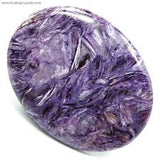Charoite
 River. It has been reported only from the Sakha Republic, Siberia, Russia. It is found where a syenite of the Murunskii Massif has intruded into and altered limestone deposits producing a potassium feldspar metasomatite.
With light to medium dark purple colors and swirling patterns, charoite is one of the few gemstones so distinctive that a gemologist can make a sight identification with confidence. No other material is likely to be mistaken for it.
River. It has been reported only from the Sakha Republic, Siberia, Russia. It is found where a syenite of the Murunskii Massif has intruded into and altered limestone deposits producing a potassium feldspar metasomatite.
With light to medium dark purple colors and swirling patterns, charoite is one of the few gemstones so distinctive that a gemologist can make a sight identification with confidence. No other material is likely to be mistaken for it.
Color: Violet, lilac, light brown Mohs scale hardness: 5 - 6
Like lapis lazuli, the gemstone we call charoite is actually a rock. However, it’s almost purely composed of the mineral charoite. This dominant mineral gives this
 material its distinctive range of purple colors, which can vary even within a single specimen. Its characteristic swirling pattern is due to its fibrous crystals arrayed in complex, interlocking patterns. The mix of other minerals includes prismatic orange tinaksite crystals, pale greenish grey microcline feldspar, and greenish black aegirine-augite crystals. As a result, this is a unique, highly ornamental rock. Due to this mixture, charoite also produces scenic stones, pieces that show so-called “natural pictures” that may resemble landscapes or even objects.
material its distinctive range of purple colors, which can vary even within a single specimen. Its characteristic swirling pattern is due to its fibrous crystals arrayed in complex, interlocking patterns. The mix of other minerals includes prismatic orange tinaksite crystals, pale greenish grey microcline feldspar, and greenish black aegirine-augite crystals. As a result, this is a unique, highly ornamental rock. Due to this mixture, charoite also produces scenic stones, pieces that show so-called “natural pictures” that may resemble landscapes or even objects.
History
“Lilac stone” was first discovered in the 1940s in the Chara River area in the Sakha Republic, Russia. In the 1970s, this gem entered Western markets as charoite. It made an impact immediately. Traditional lapidaries could make cabochons from the material, while carvers could make decorative objects. Since charoite can be a massive material, these objects may even include bookends, vases, and goblets.
Metaphysical Properties
Often called the 'stone of transformation' and 'the stone of power', charoite  earned its pseudonyms through its ability to transform negative emotions into positive feelings of well-being. It is also thought to encourage inner-strength and assertiveness. As a stone of inspiration, charoite is believed to enhance creativity, spirituality and self-esteem. It is a very soulful stone, often used for grounding the spiritual-self, ideal for opening and balancing of the crown, third eye and solar plexus chakras.
earned its pseudonyms through its ability to transform negative emotions into positive feelings of well-being. It is also thought to encourage inner-strength and assertiveness. As a stone of inspiration, charoite is believed to enhance creativity, spirituality and self-esteem. It is a very soulful stone, often used for grounding the spiritual-self, ideal for opening and balancing of the crown, third eye and solar plexus chakras.
Care
Although reasonably tough with a hardness between 5 and 6, charoites make poor ring stones. However, most other jewelry uses are safe. Due to the material’s heat sensitivity and fair to good cleavage, avoid mechanical cleaning such as steam or ultrasonic processes. Instead, use a soft brush, mild detergent, and warm water for cleaning.
Sorry, there are no products matching your search.
